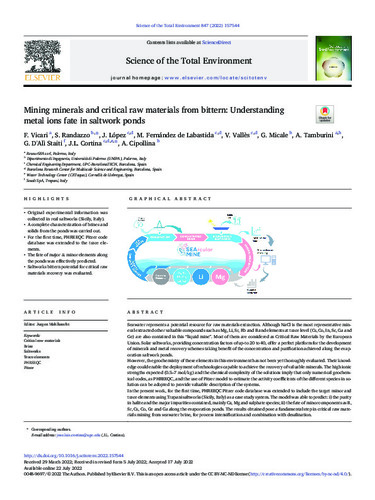Mostra el registre d'ítem simple
Mining minerals and critical raw materials from bittern: Understanding metal ions fate in saltwork ponds
| dc.contributor.author | Vicari, Fabrizio |
| dc.contributor.author | Randazzo, Serena |
| dc.contributor.author | López Rodríguez, Julio |
| dc.contributor.author | Fernández de Labastida Ventura, Marcos |
| dc.contributor.author | Vallés Nebot, Víctor |
| dc.contributor.author | Micale, Giorgio |
| dc.contributor.author | Tamburini, Alessandro |
| dc.contributor.author | D'alì Staiti, Giacomo |
| dc.contributor.author | Cortina Pallás, José Luís |
| dc.contributor.author | Cipollina, Andrea |
| dc.contributor.other | Universitat Politècnica de Catalunya. Departament d'Enginyeria Química |
| dc.contributor.other | Universitat Politècnica de Catalunya. Doctorat en Enginyeria de Processos Químics |
| dc.date.accessioned | 2022-10-27T11:28:19Z |
| dc.date.available | 2022-10-27T11:28:19Z |
| dc.date.issued | 2022-11 |
| dc.identifier.citation | Vicari, F. [et al.]. Mining minerals and critical raw materials from bittern: Understanding metal ions fate in saltwork ponds. "Science of the total environment", Novembre 2022, vol. 847, p. 157544. |
| dc.identifier.issn | 0048-9697 |
| dc.identifier.uri | http://hdl.handle.net/2117/375142 |
| dc.description.abstract | Seawater represents a potential resource for raw materials extraction. Although NaCl is the most representative mineral extracted other valuable compounds such as Mg, Li, Sr, Rb and B and elements at trace level (Cs, Co, In, Sc, Ga and Ge) are also contained in this “liquid mine”. Most of them are considered as Critical Raw Materials by the European Union. Solar saltworks, providing concentration factors of up-to 20 to 40, offer a perfect platform for the development of minerals and metal recovery schemes taking benefit of the concentration and purification achieved along the evaporation saltwork ponds. However, the geochemistry of these elements in this environment has not been yet thoroughly evaluated. Their knowledge could enable the deployment of technologies capable to achieve the recovery of valuable minerals. The high ionic strengths expected (0.5–7 mol/kg) and the chemical complexity of the solutions imply that only numerical geochemical codes, as PHREEQC, and the use of Pitzer model to estimate the activity coefficients of the different species in solution can be adopted to provide valuable description of the systems. In the present work, for the first time, PHREEQC Pitzer code database was extended to include the target minor and trace elements using Trapani saltworks (Sicily, Italy) as a case study system. The model was able to predict: i) the purity in halite and the major impurities contained, mainly Ca, Mg and sulphate species; ii) the fate of minor components as B, Sr, Cs, Co, Ge and Ga along the evaporation ponds. The results obtained pose a fundamental step in critical raw materials mining from seawater brine, for process intensification and combination with desalination. |
| dc.description.sponsorship | This work was supported by the EU within SEArcularMINE (Circular Processing of Seawater Brines from Saltworks for Recovery of Valuable Raw Materials) project – Horizon 2020 programme, Grant Agreement no. 869467. This output reflects only the author's view. The European Health and Digital Executive Agency (HaDEA) and the European Commission can- not be held responsible for any use that may be made of the information contained therein. Sosalt saltworkers Giuseppe and Giovanni Culcasi are thankfully ac- knowledged for sharing their ancestral knowledge with the SEArcularMINE project. Dr. C. Ayora from IDAEA-CSIC (Barcelona, Spain) is acknowledged for his help on the review of the PHREEQC Pitzer data base completion and guidance on the modelling stage and on the discussion and results interpre- tation of the mineralogical data from the solid samples collected on the bot- tom parts of the ponds. |
| dc.language.iso | eng |
| dc.publisher | Elsevier |
| dc.rights | Attribution-NonCommercial-NoDerivatives 4.0 International |
| dc.rights.uri | http://creativecommons.org/licenses/by-nc-nd/4.0/ |
| dc.subject | Àrees temàtiques de la UPC::Enginyeria química |
| dc.subject.lcsh | Raw materials |
| dc.subject.lcsh | Seawater |
| dc.subject.lcsh | Water chemistry -- Computer programs |
| dc.subject.other | Critical raw materials |
| dc.subject.other | BrineSaltworks |
| dc.subject.other | Trace elements |
| dc.subject.other | PHREEQC |
| dc.subject.other | Pitzer |
| dc.title | Mining minerals and critical raw materials from bittern: Understanding metal ions fate in saltwork ponds |
| dc.type | Article |
| dc.subject.lemac | Matèries primeres |
| dc.subject.lemac | Aigua de mar |
| dc.subject.lemac | Aigua -- Química |
| dc.contributor.group | Universitat Politècnica de Catalunya. R2EM - Resource Recovery and Environmental Management |
| dc.identifier.doi | 10.1016/j.scitotenv.2022.157544 |
| dc.description.peerreviewed | Peer Reviewed |
| dc.relation.publisherversion | https://www.sciencedirect.com/science/article/pii/S0048969722046423 |
| dc.rights.access | Open Access |
| local.identifier.drac | 34165152 |
| dc.description.version | Postprint (published version) |
| dc.relation.projectid | info:eu-repo/grantAgreement/EC/H2020/869467/EU/Circular Processing of Seawater Brines from Saltworks for Recovery of Valuable Raw Materials/SEArcularMINE |
| local.citation.author | Vicari, F.; Randazzo, S.; Lopez, J.; Fernandez de Labastida, M.; Vallès, V.; Micale, G.; Tamburini, A.; D'alì Staiti, G.; Cortina, J.; Cipollina, A. |
| local.citation.publicationName | Science of the total environment |
| local.citation.volume | 847 |
| local.citation.startingPage | 157544 |
Fitxers d'aquest items
Aquest ítem apareix a les col·leccions següents
-
Articles de revista [122]
-
Articles de revista [210]
-
Articles de revista [2.219]


